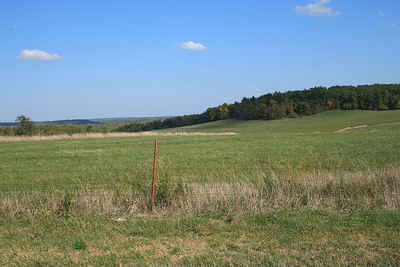
Missouri Symbols
Missouri State Dinosaur
(Hypsibema missouriensis
 )
)
Adopted in July 9, 2004.
The Hypsibema missouriensis - pronounced hip-suh-BEE-muh mi-zur-ee-EN-sis., whose name means big lizard, a 35-foot-long creature with 1,000 teeth was chosen as Missouri's official state dinosaur on July 9, 2004. The Hypsibema Missouriensis is a large, duck-billed, plant-eating sauropod.
Originally Neosaurus missouriensis, first renamed to Parrosaurus missouriensis, and also spelled Hypsibema missouriense. Bones of the species were discovered in 1942, at what later became known as the Chronister Dinosaur Site near Glen Allen, Missouri. The remains of Hypsibema missouriensis at the site, which marked the first known discovery of dinosaur remains in Missouri, are the only ones to have ever been found. Although first thought to be a sauropod, later study determined that it was a hadrosaur, or "duck-billed"dinosaur, whose snouts bear likeness to ducks' bills. Some of the species' bones found at the Chronister Dinosaur Site are housed in Washington, D.C.'s Smithsonian Institution
The Hypsibema Missouriensis was adopted in July 9, 2004 as Missouri's State Dinosaur.
Missouri State Dinosaur:
(Hypsibema missouriensis)

The Hypsibema missouriense is a "duck-billed" dinosaur and was chosen as the state's official dinosaur on July 9, 2004. It ate plants and had over 1,000 teeth. It lived in Missouri during the Late Cretaceous Period and was discovered in 1942 by Dan Stewart, near the town of Glen Allen, Missouri.
The Chronister Dinosaur Site near Glenallen, Mo., was discovered in 1942 when the Chronister family found bones while digging a well. Some of the bones discovered are in the Smithsonian Institution in Washington, D.C. Some now are in the Bollinger County Museum of Natural History.
Among them are teeth of hypsibema missouriensis, a species of duck-billed dinosaur that lived in this region 65 million years ago. The Chronister Dinosaur Site is the only location on Earth where remains of that dinosaur species have been found.
Missouri's official dino-designate would have laid its eggs in a coastal plain - and southern Missouri, 67 million years ago, may have been less than 20 miles from the Gulf of Mexico.
Described as a sauropod by Gilmore in 1945 as Neosaurus in the Journal of Paleontology. Later that year by Gilmore and Stewart renamed it as Parrosaurus because the name Neosaurus that Gilmore gave to this specimen was preoccupied . In 1979 this dinosaur was transferred to the family called "Hypsibema" so it became Hypsibema missouriensis. The type material consist of thirteen vertebrae from Ripley Formation (Late Cretaceous Period) in Bolinger County, Missouri. It was collected in 1942 by L. Chronister.
In the 1980's, Dr. Stinchcomb, with assistance from Dr. David Parris and Dr. Barbara Grandstaff of the New Jersey State Museum, conducted a series of test excavations. These new fossils made it possible for Dr. Parris and Dr. Grandstaff to determine that Hypsibema is not a sauropod after all, but rather a hadrosaur. Hadrosaurs are also called "duck-billed" dinosaurs because their snout superficially resembles a duck's bill.
Missouri Law
The law designating the "Hypsibema missouriensis" dinosaur as the official Missouri state dinosaur is found in the Missouri Revised Statutes, Title 2, Chapter 10, Section 10.095
HB 1209 - Official State Dinosaur. Names the Hypsibema missouriensis as the official state dinosaur. (signed 7/9/04)
Missouri Revised Statutes
Chapter 10
State Emblems
Section 10.095
August 28, 2005
State dinosaur.
10.095. The Hypsibema missouriensis dinosaur is hereby selected for, and shall be known as, the official dinosaur of the state of Missouri.
(L. 2004 H.B. 1209)
Taxonomic Hierarchy: Hypsibema missouriensis
Kingdom: Animalia
Phylum: Chordata
Class: Sauropsida
Superorder: Dinosauria
Order: Ornithischia
Suborder: Ornithopoda
Infraorder: Iguanodontia
Superfamily: Hadrosauroidea
Genus: Hypsibema - Cope, 1869
Species: H. missouriensis







